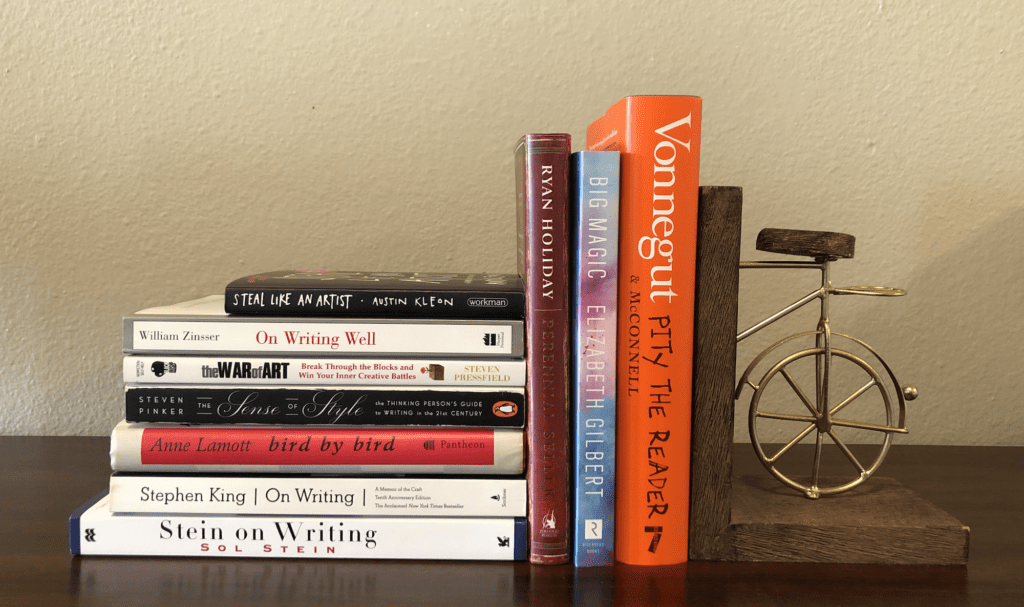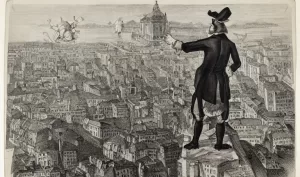The 10 Best Writing Advice Books

Once I mounted the courage to finally start writing, I realized that I had no clue what I was doing, so I turned to the only place I knew for inspiration: writing advice books.
I’ve now read many of the top books in the field and even had the chance to publish a featured series with The Writing Cooperative highlighting advice from the best writers of all time. From all of the writing craft books I’ve read, these are the ten best ones. They’ll inspire you, educate you, and propel your writing career to a new level.
On Writing Well by William Zinsser
Don’t let Zinsser’s lack of name recognition fool you. The guy is a titan in the field. Not only did this book sell a remarkable 1.5 million copies, but Zinsser also wrote 18 other books about a slew of topics including baseball, jazz music, and travel.
Zinsser believed clarity should be the main ambition of an author. If your readers understand what you’re trying to say, you’ve won half the battle.
“Good writing has an aliveness that keeps the reader reading from one paragraph to the next, and it’s not a question of gimmicks to ‘personalize’ the author. It’s a question of using the English language in a way that will achieve the greatest clarity and strength.” -William Zinsser
Zinsser concedes that style is important, but he encourages writers that style will emerge naturally over time. The most important thing is to master the art of clarity. Seek clarity first and you’ll discover style along the way.
→ Read Zinsser’s top writing tips
Steal Like an Artist by Austin Kleon
Sometimes I feel like the world is pushing me to read someone’s work because their name suddenly pops up everywhere I look. That happened with Austin Kleon. Three different books mentioned Kleon, so I succumbed to fate and picked up Kleon’s book Steal Like an Artist.
The premise of the book is that every creative person is essentially a thief. Any artist, musician, or writer worth a damn has stolen ideas from others and weaved those ideas into their own work.
“What a good artist understands is that nothing comes from nowhere. All creative work builds on what came before. Nothing is completely original.” -Austin Kleon
Yes, as writers, we must credit back to our sources and give credit where it’s due, but every artistic undertaking is an amalgamation of all creative works that preceded it. And that’s a beautiful thing.
→ Read Kleon’s top writing tips
Bird by Bird by Anne Lamott
Anne Lamott has written countless successful fiction and nonfiction books across topics as diverse as depression, faith, motherhood, and alcoholism.
Lamott writes truthful, vulnerable stories about topics others don’t want to acknowledge. She believes that an author’s best tool is the truth.
“We write to expose the unexposed. If there is one door in the castle you have been told not to go through, you must (open the door)…You can’t do this without discovering your own true voice, and you can’t find your true voice and peer behind the door and report honestly and clearly to us if your parents are reading over your shoulder. They are probably the ones who told you not to open that door in the first place. You can tell if they’re there because a small voice will say, ‘Oh, whoops, don’t say that, that’s a secret,’ or ‘That’s a bad word,’ or ‘Don’t tell anyone you jack off. They’ll all start doing it.’ So you have to breathe or pray or do therapy to send them away. Write as if your parents are dead.” -Anne Lamott
Bird by Bird offers advice for how to ignore your critics, write from the heart, ruthlessly edit your work, and find stories in the everyday events of life.
→ Read Lamott’s top writing tips
Pity the Reader by Kurt Vonnegut and Suzanne McConnell
Vonnegut had one of the most unique writing styles of all time. He meshed fantastical elements and otherworldly storytelling with gripping social commentary on themes like pacifism, technology, and social equity.
In Pity the Reader, Vonnegut’s former student Suzanne McConnell compiles Vonnegut’s writing wisdom for those of us who never had the chance to meet the literary legend.
“When I teach — and I’ve taught at the Iowa Writers’ Workshop for a couple of years, at City College, Harvard — I’m not looking for people who want to be writers. I’m looking for people who are passionate, who care terribly about something.” -Kurt Vonnegut
As he saw it, the most compelling stories all contained one key ingredient: passion. And Vonnegut believed that passionate writing was one of the best ways to effect social change. That’s why he chose to protest America’s constant wars by picking up a pen instead of a protest sign. He channeled his emotion into writing the best damn novel he could to express his anger about unnecessary war: Slaughterhouse-Five.
→ Read Vonnegut and McConnell’s top writing tips
On Writing by Stephen King
There’s a reason why this book is cited by seemingly every author online. It’s excellent. Not only is King one of the most successful writers on the planet, but he’s also someone who has pushed literary boundaries for decades.
In school, teachers frowned upon young King for his dark, gruesome stories, and when King published his novel Carrie in 1973, horror was still a sideshow genre. But rather than shy away from his dark fantasies, King learned to embrace them and marshal them into page-turning fiction.
He encourages all writers to write about their interests and in plain-speak rather than trying to sound smart or professional.
“One of the really bad things you can do to your writing is to dress up the vocabulary, looking for long words because you’re maybe a little bit ashamed of your short ones. This is like dressing up a household pet in evening clothes. The pet is embarrassed and the person who committed this act of premeditated cuteness should be even more embarrassed.” -Stephen King
→ Read King’s top writing tips
Perennial Seller by Ryan Holiday
Super Bowl champions, golf pros, and Olympians have cited Ryan Holiday as their inspiration for mental toughness and perseverance. Holiday’s books about modern Stoicism are incredible, as is his book Perennial Seller, which explores how to create a work of art that lasts for centuries.
Holiday is a great marketer — he was formerly Director of Marketing for American Apparel — but he says that marketing something is nowhere near as important as creating something work marketing. And what is required to create something meaningful? Hundreds of hours of tireless work.
“The difference between a great work and an idea for a great work is all the sweat, time, effort, and agony that go into engaging that idea and turning it into something real. That difference is not trivial. If great work were easy to produce, a lot more people would do it.” -Ryan Holiday
Perennial Seller weds tactical tips and with a pleasant kick in the pants to help you get off the couch and put in the time to write something of substance.
→ Read Holiday’s top writing tips
The War of Art by Steven Pressfield
Pressfield’s imagery and storytelling are so realistic that West Point, the U.S. Naval Academy, and the Marine Corps teach his book Gates of Fire to their young cadets to help them learn about war.
Despite Pressfield’s literary prowess, he still battles demons in his writing process. He calls his enemy Resistance, and he takes up arms against this Resistance every day when he sits down to do his work.
“Resistance will unfailingly point to true North — meaning that calling or action it most wants to stop us from doing. We can use this. We can use it as a compass. We can navigate by Resistance, letting it guide us to that calling or action that we must follow before all others.” -Steven Pressfield
The War of Art is one of the shortest books on this list and also one of the most memorable. Pressfield’s humility and artistic vulnerability make this book a must-read for any creative.
→ Read Pressfield’s top writing tips
Big Magic by Elizabeth Gilbert
I was one of the snobs who turned up their nose at Eat Pray Love as it roosted on the New York Times bestseller list for 187 weeks. But any writer who can captivate millions of readers with a memoir of her life is an exceptional storyteller.
Gilbert freely admits that she’s not a super-genius; she just works hard and writes a lot. She says that one of the world’s biggest lies is that only the “select few” are called to be artists and makers when in reality, everyone is creative. We all have big magic inside of us.
“So this, I believe, is the central question upon which all creative living hinges: Do you have the courage to bring forth the treasures that are hidden within you?” -Elizabeth Gilbert
Writing takes bravery, and Gilbert helps readers realize that the best stories are the ones that are the bravest and most authentic.
→ Read Gilbert’s top writing tips
The Sense of Style by Steven Pinker
You’ve likely seen Pinker’s books on the shelves of your local bookstore. Even though he’s a huge name in nonfiction, you won’t hear many people mention this book because it’s overshadowed by all of Pinker’s other work.
One of my biggest takeaways from this book was the importance of simplifying complex details for your readers. Great writing is simple but powerful. It logically builds from one idea to the next, and you’ll need to spend a lot of time cleaning up your work to make it easy for readers to understand.
“It takes cognitive toil and literary dexterity to pare an argument to its essentials, narrate it in an orderly sequence, and illustrate it with analogies that are both familiar and accurate. As Dolly Parton said, ‘You wouldn’t believe how much it costs to look this cheap.’” -Steven Pinker
The Sense of Style offers hundreds of practical examples. Pinker walks through text snippets from other books, media, and academia to contrast strong versus weak writing. By the end of the book, you emerge as Pinker’s proficient pupil, ready to take on your next writing challenge.
→ Read Pinker’s top writing tips
Stein on Writing by Sol Stein
This is another book that doesn’t get enough press. I’ve only ever heard one person talk about this book, which is a shame because it’s arguably the most practical writing advice book ever written.
Sol Stein was a longtime editor and publisher who also wrote 13 books. He wrote novels, nonfiction, and screenplays; edited the work of James Baldwin; and published stories from authors like Bertram Wolfe and George Orwell.
He believed that the best way to develop characters was through their actions — a dictum that can be equally applied to both fiction and nonfiction.
“We individualize by seeing characters doing things and saying things, not by the author telling us about them. Don’t ever stop your story to characterize. Avoid telling the reader what your character is like. Let the reader see your characters talking and doing things.” -Sol Stein
I don’t promise many things at the end of articles, but I can promise that if you invest the time to read these books and apply their lessons, you’ll become a stronger writer. Best of luck, my friend.
Want to purchase one of these books? Check out the full list here on Bookshop!
Want to become a stronger leader?
Sign up to get my exclusive
10-page guide for leaders and learners.




